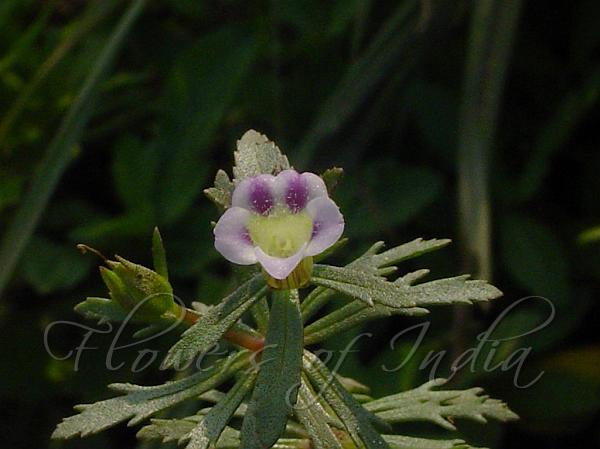|
| Indian Marshweed |
|

|

| File size | 193224 |
| Original date | 1/4/09 2:04 PM |
| Resolution | 2048 x 1536 |
| Flash | Flash did not fire |
| Focal length | 6.3mm |
| Exposure time | 1/400s |
| Aperture | 8.0 |
| Focus Distance | |
| Metering Mode | Spot |
| Camera make | SONY |
| Camera model | DSC-P52 |
| Sensor type |
|
|
|
|
Photo: |
Botanical name: Limnophila indica Family: Plantaginaceae (Plantain family)
Synonyms: Hottonia indica, Limnophila gratioloides
Synonyms: Hottonia indica, Limnophila gratioloides
Indian Marshweed is a perennial herb which can live in water and on land.
Submerged stems much branched, hairless. Aerial stems are up to 15 cm,
simple or branched, hairless, with stalked or stalkless glands. Submerged
leaves are whorled, 1.5-2.5 cm, pinnately cut into segments which are
flattened to capillary. Aerial leaves are usually whorled, pinnately
lobed, 0.4-2 cm, sometimes few opposite and toothed. Flowers arise singly
in the axils of aerial leaves. Flower stalk is slender, 2-10 mm, usually
longer than bract. Bracteoles 2, 1.5-3.5 mm, margin entire or sparsely
serrate, apex acute. Sepal cup is 3.5-5 mm, with stalkless glands, sepals
2-3 mm, ovate to lanceshaped, tip short pointed. Flowers are white or pale
purple, 1-1.4 cm. Petals are botched with dark purple or reddish spots.
Capsule is dark brown, compressed, ellipsoid to round, 3 mm. Indian
Marshweed is found in India, including the Himalayas, at altitudes of
200-2300 m. Flowering: March-November.
| Identification credit: Prashant Awale | Photographed at Pashan Lake, Pune, Maharashtra & Chennai, Tamilnadu. |
• Is this flower misidentified? If yes,